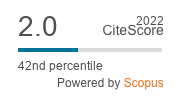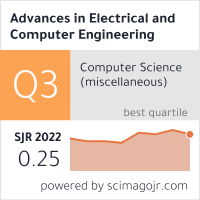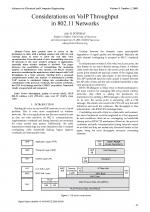| 3/2009 - 9 |
Considerations on VoIP Throughput in 802.11 NetworksPOTORAC, A. D. |
| View the paper record and citations in |
| Click to see author's profile in |
| Download PDF |
Author keywords
throughput, quality of service (QoS), IEEE 802.22 wireless LAN (WLAN), voice over IP (VoIP), voice codec
References keywords
networks(4)
Blue keywords are present in both the references section and the paper title.
About this article
Date of Publication: 2009-10-26
Volume 9, Issue 3, Year 2009, On page(s): 45 - 50
ISSN: 1582-7445, e-ISSN: 1844-7600
Digital Object Identifier: 10.4316/AECE.2009.03009
Web of Science Accession Number: 000271872000009
SCOPUS ID: 77954738959
Abstract
Voice data packets have to arrive at the destination in time, with a defined cadence and with low and constant delay in order to allow the real time voice reconstruction. From this point of view, transmitting voice over IP networks is the most sensitive category of applications, especially when wireless medium is involved. The paper discusses the possibilities of transmitting the maximum number of simultaneous voice streams over 802.11 wireless networks considering the main factors which impact with VoIP throughput, in a basic scenario. Starting from a proposed communication model, the number of simultaneous possible VoIP sessions is calculated, taking into consideration the contribution of the protocol overheads, the security overheads, the PHY level timings and the CODEC proprieties. Numerical results are generated and compared. |
| References | | | Cited By «-- Click to see who has cited this paper |
| [1] Daji Qiao, Sunghyun Choi, "Goodput Analysis and Link Adaptation for IEEE 802.11a Wireless LANs", IEEE Transactions on Mobile Computing, vol.1, No.4, 2002 [CrossRef] [2] "IEEE 802.11, Wireless LAN Medium Access Control (MAC) and Physical Layer (PHY) Specifications", Standard, IEEE, Aug. 1999 [3] "ITU-T Recommendation G.114. 2003", One way transmission time [4] "ITU-T Recommendation G.107. 2003", The E-model, a computational model for use in transmission planning [5] Mohd Alias, Ong Lee Loon, "Performance of Voice over IP over Wireless LAN for different Audio/Voice Codecs", Jurnal Teknologi, 47(D), Universiti Teknologi Malaysia, 2007 [6] Potorac Alin Dan, Eugen Coca, "QoS Considerations for 802.11 Networks", European Conference on the Use of Modern Information and Communication technologies, ECUMICT '06, Ghent, Belgium, 2006 [7] Raghuraman Rangarajan, Sridhar Iyer, Atanu Guchhait, "Automated design of VoIP-enabled 802.11g WLANs", OPNET Annual Networking Conference (OPNETWORK), Washington D.C., USA, Aug 2005 [8] Taiwen Tang, Ketan Mandke, Chan-Byoung Chae, Robert W. Heath, Jr. and Scott M. Nettles, "Multichannel Feedback in OFDM Ad Hoc Networks", The 3rd Annual IEEE Communications Society on Sensor and Ad Hoc Communications and Networks, Volume 2, 2006 [CrossRef] [9] Wei Wang, Soung C. Liew, and Victor O. K. Li, "Solutions to Performance Problems in VoIP over a 802.11 Wireless LAN", IEEE Transactions On Vehicular Technology, 2005 [CrossRef] [Web of Science Times Cited 182] [10] Potorac Alin Dan and Balan Doru, "The Impact of Security Overheads on 802.11 WLAN Throughput", Journal of Computer Science and Control Systems, University of Oradea, vol.2, No.1, 2009 [11] Tiliute, D. E., "Security of Mobile ad-hoc Wireless Networks. A Brief Survey", Advances in Electrical and Computer Engineering, ISSN 1582-7445, e-ISSN 1844-7600, vol. 7, no. 2, pp. 37-40, 2007 [CrossRef] [Full Text] [Web of Science Times Cited 5] [12] Marian, N., Top, S., "Integration of Simulink Models with Component-based Software Models", Advances in Electrical and Computer Engineering, ISSN 1582-7445, e-ISSN 1844-7600, vol. 8, no. 2, pp. 3-10, 2008 [CrossRef] [Full Text] [Web of Science Times Cited 3] Web of Science® Citations for all references: 190 TCR SCOPUS® Citations for all references: 0 Web of Science® Average Citations per reference: 15 ACR SCOPUS® Average Citations per reference: 0 TCR = Total Citations for References / ACR = Average Citations per Reference We introduced in 2010 - for the first time in scientific publishing, the term "References Weight", as a quantitative indication of the quality ... Read more Citations for references updated on 2024-04-21 01:27 in 31 seconds. Note1: Web of Science® is a registered trademark of Clarivate Analytics. Note2: SCOPUS® is a registered trademark of Elsevier B.V. Disclaimer: All queries to the respective databases were made by using the DOI record of every reference (where available). Due to technical problems beyond our control, the information is not always accurate. Please use the CrossRef link to visit the respective publisher site. |
Faculty of Electrical Engineering and Computer Science
Stefan cel Mare University of Suceava, Romania
All rights reserved: Advances in Electrical and Computer Engineering is a registered trademark of the Stefan cel Mare University of Suceava. No part of this publication may be reproduced, stored in a retrieval system, photocopied, recorded or archived, without the written permission from the Editor. When authors submit their papers for publication, they agree that the copyright for their article be transferred to the Faculty of Electrical Engineering and Computer Science, Stefan cel Mare University of Suceava, Romania, if and only if the articles are accepted for publication. The copyright covers the exclusive rights to reproduce and distribute the article, including reprints and translations.
Permission for other use: The copyright owner's consent does not extend to copying for general distribution, for promotion, for creating new works, or for resale. Specific written permission must be obtained from the Editor for such copying. Direct linking to files hosted on this website is strictly prohibited.
Disclaimer: Whilst every effort is made by the publishers and editorial board to see that no inaccurate or misleading data, opinions or statements appear in this journal, they wish to make it clear that all information and opinions formulated in the articles, as well as linguistic accuracy, are the sole responsibility of the author.





